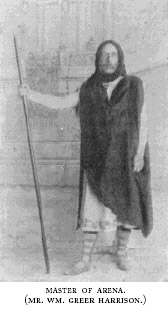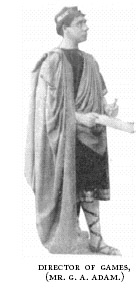The president of the Olympic was, until recently, Mr. William Greer Harrison, one of the most earnest supporters of amateur sports on the Pacific slope. Early in 1893 he suggested a grand reproduction of the combats of the Roman amphitheater, and a revival of the games of the ancient Greek athletes at Olympia. The idea was a bold one, but, after some contention and opposition, it was decided to carry it out. The largest building in San Francisco was hired, the Mechanics' Pavilion, built for the annual Exhibition of Arts and Manufactures. Painters and decorators under the direction of M. Amedee Joullin, invaded the huge building, and, by the aid of wood and canvas painted to give an idea of innumerable arches and galleries stretching away into a dim distance, transformed it into a very creditable likeness of the Flavian Amphitheater, or Coliseum. The illusion was enhanced by drawing sky-blue canvas, partly screened by an awning, over the entire area. The floor was covered with six inches of soil, coated with sand, and powerful gas and lime lights were provided. |
The box in which Cæsar and his courtiers were to sit was painted and decorated after the famous picture of M. Gerôme, entitled "Pollice Verso." In this great picture the artist represents a fallen gladiator suing for mercy from the spectators, who are giving the signal for his death to the victor by turning down their thumbs. When the doors of the Pavilion opened, on the night of April seventeenth, a crowd of sight-seers, attracted by the novelty of the entertainment and the popularity of the club, swarmed in, and half an hour before the performance began not one un-reserved seat could be obtained, and many even of the reserved ones were seized and occupied by the eager throng. Though I have lived five years in San Francisco, and have been to every kind of public entertainment, I have never seen audiences which for brilliancy and enthusiasm equaled those gathered in the Circus Maximus. While the audience impatiently awaited the entrance of Cæsar, the band, in costumes of white with a broad blue stripe round the neck,  |
page 1 | page 2 | page 3 | page 4 | page 5 | page 6 | page 7 | page 8
 THE progress of to-day is marked by a tendency towards a revival of the artistic past-Old London figures in the modern metropolis, old Greek plays flourish in every dramatic detail in the modern universities, not as declamatory exercises but as art efforts, and to apparently cap the climax, the farthest West, California, is the first to restore to modern eyes the glories of the Græco-Roman games. This achievement was carried to a successful issue under the auspices of the principal athletic club on the Pacific Coast, the Olympic Club of San Francisco, one of the best-equipped clubs of its kind in the United States.
THE progress of to-day is marked by a tendency towards a revival of the artistic past-Old London figures in the modern metropolis, old Greek plays flourish in every dramatic detail in the modern universities, not as declamatory exercises but as art efforts, and to apparently cap the climax, the farthest West, California, is the first to restore to modern eyes the glories of the Græco-Roman games. This achievement was carried to a successful issue under the auspices of the principal athletic club on the Pacific Coast, the Olympic Club of San Francisco, one of the best-equipped clubs of its kind in the United States.